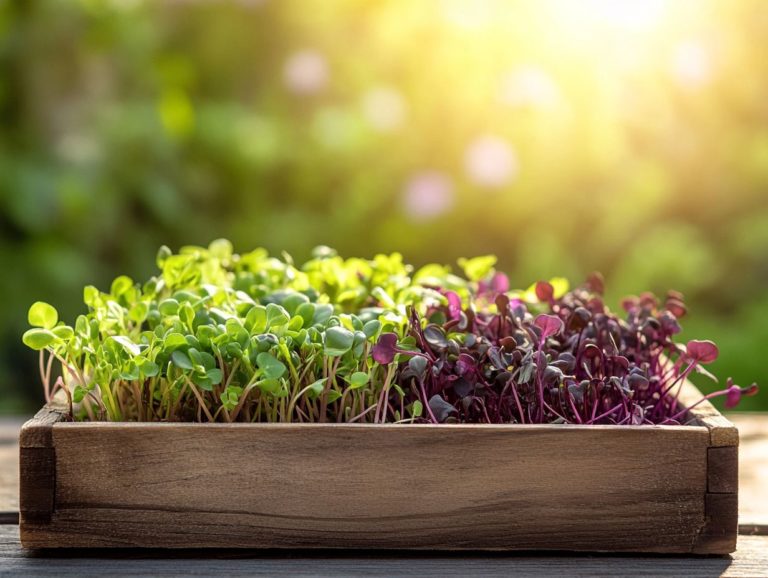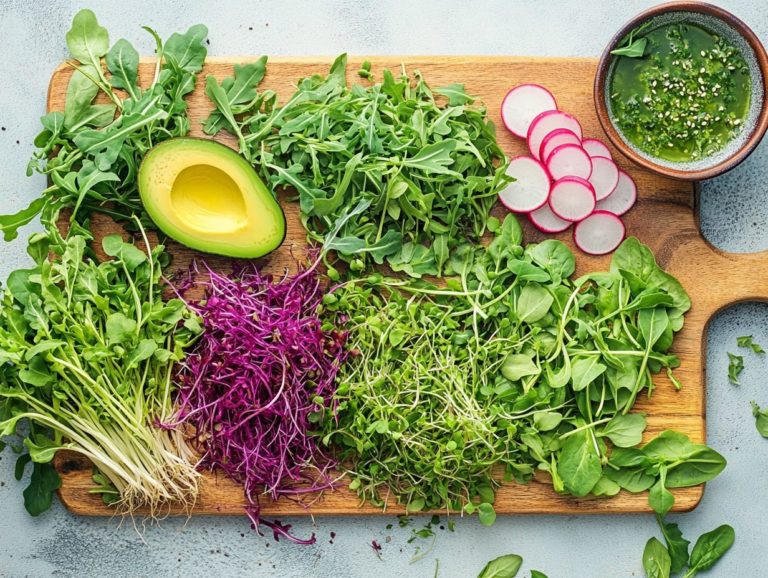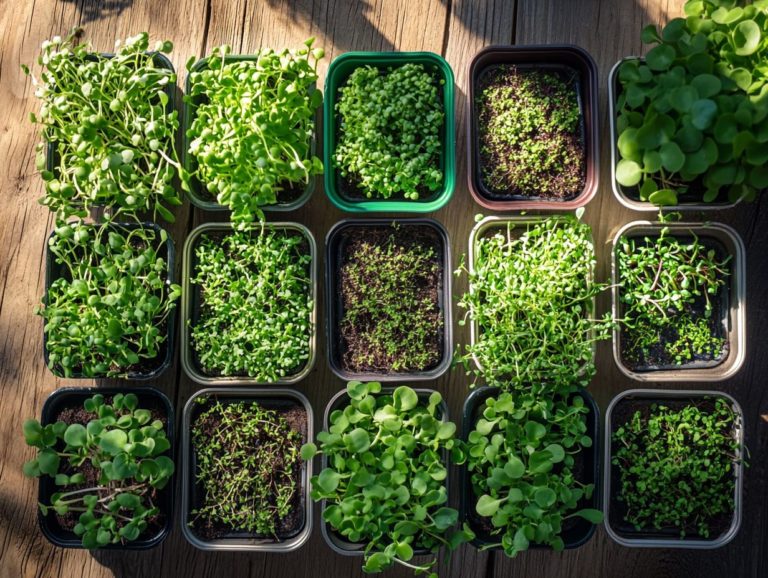How to Maximize Health Benefits from Microgreens
Microgreens are small, nutrient-dense plants that can truly elevate your meals and enhance your well-being. This article delves into the world of microgreens and uncovers their remarkable nutritional benefits.
You’ll find guidance on how to grow your own, highlighting the best varieties and the unique health advantages each offers. You will find creative ways to use these vibrant greens in your meals, along with tips for optimal storage and important precautions to keep in mind.
Ready to transform your meals and boost your health? Let s get started!
Contents
Key Takeaways:

- Include a variety of microgreens in your diet to reap the full range of nutritional benefits.
- Be sure to consume microgreens at their peak freshness for maximum health benefits.
- Follow proper storage and handling techniques to minimize potential risks associated with consuming microgreens.
What are Microgreens?
Microgreens are the young vegetables harvested just after the first leaves emerge. These nutrient-dense plants are not only gaining traction in urban farming but also offer remarkable culinary versatility and an impressive spectrum of health benefits.
Packed with concentrated nutrients, microgreens serve as exquisite flavor enhancers in a variety of dishes. This makes them the go-to option for health-conscious consumers seeking sustainable food choices.
As they find their way into diverse diets, microgreens are drawing attention for their potential role in disease prevention and as functional foods foods that have a positive effect on health beyond basic nutrition elevating your meals to new heights of wellness.
Definition and Nutritional Benefits
Microgreens are a treasure trove of nutritional benefits, brimming with high vitamin content, antioxidants, and essential dietary fiber. They make for an excellent addition to any healthy diet.
These tiny powerhouses, especially those from the Brassicaceae family a family of plants that includes broccoli and kale pack a concentrated source of nutrients in just a small serving. Research, including findings from the Cleveland Clinic, reveals that broccoli microgreens can contain up to 40 times more vitamins E and C than their fully-grown counterparts.
The phytochemicals present in these microgreens help to fortify the immune system and may also play a significant role in combating metabolic diseases. Insights from registered dietitians suggest that the antioxidants found in microgreens can enhance cognitive function, offering vital support for overall brain health and longevity. Additionally, exploring the benefits of growing diverse microgreen varieties can further maximize these health advantages.
How to Grow Your Own Microgreens
Growing your own microgreens offers a truly rewarding experience, allowing you to savor fresh produce from the comfort of your home while fully embracing sustainable food practices.
Step-by-Step Guide
To successfully grow microgreens at home, you can follow this step-by-step guide that highlights essential sprouting techniques and food safety measures.
Start with seed selection, opting for organic options to ensure your microgreens are free from harmful pesticides. Next, prepare your growing medium with high-quality soil that retains moisture while also draining well. When you sow the seeds, remember to provide ample light whether that’s natural or artificial to encourage robust growth. For a nutritious boost, consider the best microgreens for nutritional value.
As you approach the harvest, handle those delicate greens with care, using clean tools to avoid contamination. This attention to detail enhances the quality of your microgreens and helps preserve their nutrients. Urban farming becomes an excellent choice for those health-conscious individuals eager to savor the fresh flavors of homegrown produce. Start today and enjoy the freshest microgreens in just a few weeks!
Best Types of Microgreens to Grow

When exploring the world of microgreens, you’ll find that some of the finest varieties to cultivate are from the Brassicaceae family, such as broccoli and kale. These microgreens not only boast a wealth of health benefits but also elevate culinary applications and enrich flavor profiles in your dishes.
Are you ready to grow your own microgreens? Share your experiences and let s cultivate a healthier lifestyle together!
Popular Varieties and Their Health Benefits
Popular microgreen varieties like broccoli, fenugreek, and spinach are known for their health benefits, including powerful antioxidant properties and immune support.
Among these, broccoli microgreens truly shine. Not only do they offer a vibrant flavor, but they also have impressive potential in cancer prevention due to high levels of sulforaphane, a compound known for fighting cancer. To further enhance their taste, consider exploring ways to enhance flavor in microgreens. This compound plays a significant role in detoxification and shielding the body from harmful substances.
Fenugreek microgreens, with their delightful nutty flavor, are rich in iron, making them an excellent choice for anyone dealing with iron deficiency or anemia.
Meanwhile, spinach microgreens are packed with vitamins A and K, promoting eye health and supporting strong bones. By incorporating these nutritious greens into your meals and learning how to maximize yields from microgreens, you can significantly enhance your overall well-being while enjoying a delicious and natural approach to gut health.
Ways to Incorporate Microgreens into Your Diet
Incorporating microgreens into your diet is not only straightforward but also a transformative way to elevate the flavor and nutrition of your meals. This vibrant addition has become a go-to choice for those prioritizing health and wellness in their culinary pursuits.
Recipe Ideas and Tips
Here are some creative recipe ideas and tips for incorporating microgreens into your culinary repertoire, maximizing nutrient absorption.
These vibrant little greens can truly elevate a variety of dishes, enhancing both flavor and presentation. Lightly saut ing microgreens in olive oil is a great way to preserve their delicate texture while enhancing their richness.
For a fresh salad, consider combining a mix of microgreens with seasonal vegetables like radishes and cucumbers. Drizzle it with a tangy vinaigrette for a beautifully rounded flavor. Pairing these greens with fruits such as citrus or berries can amplify their nutritional benefits, offering a delightful balance of sweet and savory.
Remember, incorporating microgreens not only beautifies your meals but also significantly boosts antioxidants, fiber, essential vitamins, and polyphenols. For more insights on how to grow them effectively, check out the benefits of indoor microgreen growing, making every bite a truly healthy choice.
Maximizing Health Benefits from Microgreens
To fully harness the health benefits of microgreens, you must understand the optimal consumption methods and proper storage techniques. This knowledge is essential for preserving their valuable nutrient content and ensuring that you reap the maximum rewards from these tiny powerhouses.
Optimal Consumption and Storage

Optimal consumption of microgreens requires a keen understanding of the best cooking methods and storage practices that preserve their nutrient retention and health benefits.
To truly enjoy the advantages of these nutritious greens, avoid overcooking them; even a hint of heat can strip away their vibrant flavors and essential vitamins. A quick saut or a delicate sprinkle of fresh microgreens as a finishing touch can elevate your dishes without compromising their integrity.
In terms of storage, maintaining a slightly moist environment is crucial. Wrapping these delicate greens in a damp paper towel inside a sealed container will help them retain their crispness. You can also integrate fresh herbs alongside microgreens to enhance flavor and provide a nutritional boost. Additionally, consider exploring the benefits of growing microgreens vertically, transforming your meals into both delicious and nourishing experiences.
Potential Risks and Precautions
While microgreens provide a wealth of health benefits, it s essential to understand the potential risks and necessary precautions, particularly regarding food safety and certain health conditions.
Stay informed to enjoy all the benefits safely!
Who Should Avoid Microgreens?
Certain individuals, particularly those with compromised immune systems or specific metabolic conditions, might be advised to steer clear of microgreens due to potential food safety concerns.
This is particularly important for people undergoing chemotherapy or managing conditions like diabetes, where excessive nutrient intake could lead to negative effects.
If you re pregnant, it s wise to consult your doctor, as you may be more vulnerable to foodborne illnesses associated with raw produce.
Evaluate your health before adding microgreens to your diet. Engaging with a healthcare professional can provide you with personalized guidance, ensuring that the potential benefits of microgreens don t overshadow any health risks.
Frequently Asked Questions
How do microgreens benefit our health?
Microgreens are not just trendy; they pack a powerful nutritional punch! They are loaded with vitamins, minerals, and antioxidants, including high levels of phytochemicals natural compounds found in plants that may help protect against diseases helping reduce the risk of chronic diseases such as heart disease and cancer.
How can I incorporate microgreens into my diet?

There are many ways to include microgreens in your meals. You can add them to salads, sandwiches, and smoothies, or use them as a garnish on various dishes.
They can also replace regular greens in recipes, enhancing flavor and nutrition for health-conscious consumers.
What is the best way to store microgreens?
The best way to keep your microgreens fresh and delicious is to store them in a sealed container or plastic bag in the refrigerator. They should stay fresh for up to a week when stored this way.
It’s essential to wash and dry them thoroughly before storing to prevent spoilage, ensuring food safety and maximizing nutrient retention.
How do I know when microgreens are ready to harvest?
Microgreens are ready to harvest when they have developed their first set of true leaves, which is usually around 7-14 days after planting. You can tell they are ready by gently pulling on the greens; if they come out easily, they are ready to be harvested.
Varieties such as broccoli and fenugreek from the Brassicaceae family are popular choices among urban farming enthusiasts.
Can I grow microgreens indoors?
Yes, microgreens can easily be grown indoors with minimal equipment and space. You can use trays, containers, or even shallow pots to grow them.
It’s important to place them in an area with plenty of sunlight or use grow lights to ensure they receive adequate light, which is crucial for optimal growth conditions.
Why wait? Start exploring the world of microgreens today and boost your health!
Are there any precautions I should take when consuming microgreens?
Microgreens are safe to eat, but always wash them thoroughly before consumption. Treat them just like any fresh produce.
If you have food allergies, research the types of microgreens you want to eat. This will help you avoid any reactions.
These tiny greens offer a range of health benefits. They can help boost your immune system and may even play a role in cancer prevention. Excited to add them to your diet?






